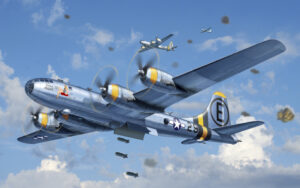 When the airmen went off to war, their hope was that their plane would be able to stand up to the attacks that would be coming their way. In World War II, big war planes were very new. The men who spent the war in them, needed a plane that would take a hit and keep on flying. They would love to have a flying suit of armor, but it also had to be able to fly. A plane that was too heavy, obviously wouldn’t fly, and yet, they needed a plane that could get hit with shrapnel or bullets and still stay in the air. They knew that they couldn’t make sure that every plane that was hit would make it home, but they needed as many as possible to do just that.
When the airmen went off to war, their hope was that their plane would be able to stand up to the attacks that would be coming their way. In World War II, big war planes were very new. The men who spent the war in them, needed a plane that would take a hit and keep on flying. They would love to have a flying suit of armor, but it also had to be able to fly. A plane that was too heavy, obviously wouldn’t fly, and yet, they needed a plane that could get hit with shrapnel or bullets and still stay in the air. They knew that they couldn’t make sure that every plane that was hit would make it home, but they needed as many as possible to do just that.
There were a number of planes that were considered almost indestructible, or at least as indestructible as it is possible to be for an airplane in a war zone. Two of them…the Boeing B-17 Flying Fortress, a four-engined heavy bomber developed in the 1930s for the United States Army Air Corps (USAAC), and the Boeing B-29 Superfortress, a US 4-engine propeller bomber, manufactured from 1943 to 1946 and used throughout the Korean War, as well as World War II. The name “Fortress” was coined when B-17, with its heavy firepower and multiple machine gun emplacements, made its public debut in July 1935. A reporter for The Seattle Times, Richard Williams, exclaimed, “Why, it’s a flying fortress!” The Boeing Company saw the value of that name and immediately had it trademarked. The truth of the matter is, however, that the planes had the ability to take a hit and still bring their boys home most of the time, provided the damage wasn’t too heavy.
These heavy bombers are bomber aircraft capable of delivering the largest payload of bombs, as well as the longest range, which is takeoff to landing distance, of their era. For those reasons, the heavy bombers are  usually among the largest and most powerful military aircraft at any point in time. Nevertheless, as the 20th century wound down, the heavy bombers were largely superseded by strategic bombers. The strategic bombers were often smaller in size, which allowed for much longer ranges and by necessity, these were capable of delivering nuclear bombs. It was a sign of the times, but for all World War II buffs, like me, it was a sad end of an era. The newer planes are great, don’t get me wrong, but they just don’t have the presence, at least in my mind, that the World War II heavy bombers did. Those old planes had a grace that the newer stuff simply doesn’t have. I suppose that my love of the B-17, at least, stems from the fact that it was the plane that brought my dad home safely…so he could become my dad.
usually among the largest and most powerful military aircraft at any point in time. Nevertheless, as the 20th century wound down, the heavy bombers were largely superseded by strategic bombers. The strategic bombers were often smaller in size, which allowed for much longer ranges and by necessity, these were capable of delivering nuclear bombs. It was a sign of the times, but for all World War II buffs, like me, it was a sad end of an era. The newer planes are great, don’t get me wrong, but they just don’t have the presence, at least in my mind, that the World War II heavy bombers did. Those old planes had a grace that the newer stuff simply doesn’t have. I suppose that my love of the B-17, at least, stems from the fact that it was the plane that brought my dad home safely…so he could become my dad.


Leave a Reply